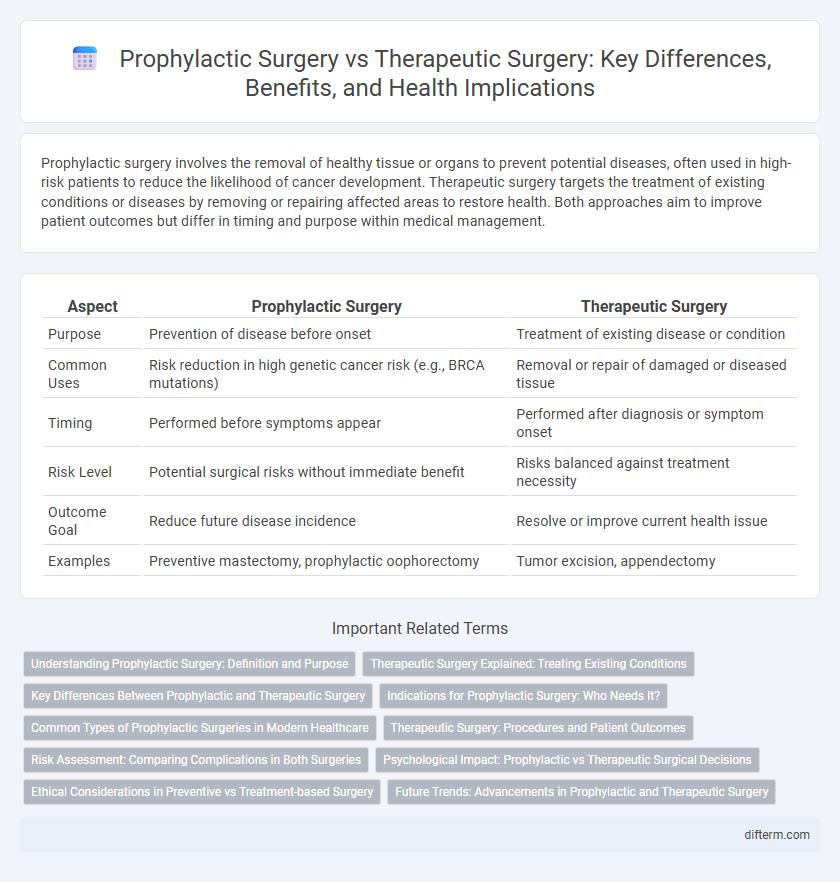Prophylactic surgery involves the removal of healthy tissue or organs to prevent potential diseases, often used in high-risk patients to reduce the likelihood of cancer development. Therapeutic surgery targets the treatment of existing conditions or diseases by removing or repairing affected areas to restore health. Both approaches aim to improve patient outcomes but differ in timing and purpose within medical management.
Table of Comparison
| Aspect | Prophylactic Surgery | Therapeutic Surgery |
|---|---|---|
| Purpose | Prevention of disease before onset | Treatment of existing disease or condition |
| Common Uses | Risk reduction in high genetic cancer risk (e.g., BRCA mutations) | Removal or repair of damaged or diseased tissue |
| Timing | Performed before symptoms appear | Performed after diagnosis or symptom onset |
| Risk Level | Potential surgical risks without immediate benefit | Risks balanced against treatment necessity |
| Outcome Goal | Reduce future disease incidence | Resolve or improve current health issue |
| Examples | Preventive mastectomy, prophylactic oophorectomy | Tumor excision, appendectomy |
Understanding Prophylactic Surgery: Definition and Purpose
Prophylactic surgery involves the removal of healthy tissue or organs to prevent the development of disease, particularly cancer, in individuals at high risk. This preventive approach aims to reduce the likelihood of disease occurrence by addressing genetic predispositions or early warning signs before symptoms arise. Understanding prophylactic surgery is crucial for patients with hereditary conditions such as BRCA gene mutations, which significantly increase the risk of breast and ovarian cancers.
Therapeutic Surgery Explained: Treating Existing Conditions
Therapeutic surgery is a medical procedure aimed at treating existing diseases or conditions by removing tumors, infected tissues, or repairing damaged structures. It focuses on alleviating symptoms, preventing disease progression, and improving patient quality of life. Common examples include tumor excision, appendectomy, and coronary artery bypass surgery.
Key Differences Between Prophylactic and Therapeutic Surgery
Prophylactic surgery involves preventive removal of tissue or organs to reduce the risk of developing diseases such as cancer, often performed on high-risk patients with genetic predispositions. Therapeutic surgery treats existing conditions by directly removing or repairing diseased tissues, such as tumor excision or organ removal due to confirmed pathology. The key difference lies in prophylactic surgery's preventive intent versus therapeutic surgery's curative or palliative purpose.
Indications for Prophylactic Surgery: Who Needs It?
Prophylactic surgery is indicated primarily for individuals with a high genetic risk of developing certain cancers, such as BRCA1 or BRCA2 mutation carriers considering mastectomy or oophorectomy to reduce breast and ovarian cancer risk. Patients with precancerous lesions or significant family history of hereditary cancer syndromes also qualify for preventative surgical interventions. This approach aims to minimize future cancer incidence by removing at-risk tissues before malignant transformation.
Common Types of Prophylactic Surgeries in Modern Healthcare
Common types of prophylactic surgeries in modern healthcare include mastectomy for high-risk breast cancer patients, oophorectomy to prevent ovarian cancer, and colectomy to reduce colorectal cancer risk in individuals with familial adenomatous polyposis. These surgeries aim to remove tissue or organs before cancer develops, significantly lowering the chance of malignancy. Advances in genetic testing and preventive medicine have made prophylactic surgeries a critical component of personalized healthcare strategies.
Therapeutic Surgery: Procedures and Patient Outcomes
Therapeutic surgery involves operative procedures aimed at treating established diseases, such as tumor resection in cancer patients or organ repair following trauma. This type of surgery focuses on improving patient outcomes by directly addressing pathological conditions, reducing symptoms, and preventing disease progression. Postoperative recovery and long-term prognosis largely depend on the surgical technique, disease stage, and patient health status.
Risk Assessment: Comparing Complications in Both Surgeries
Prophylactic surgery, performed to prevent disease, often involves lower immediate complications compared to therapeutic surgery, which treats existing conditions and carries higher risks due to disease severity. Risk assessment must consider patient-specific factors such as age, comorbidities, and surgical site to accurately predict complication rates in both approaches. Studies show that while prophylactic surgery reduces long-term disease risk, therapeutic surgery complications are more frequent and severe, impacting recovery and overall prognosis.
Psychological Impact: Prophylactic vs Therapeutic Surgical Decisions
Prophylactic surgery often reduces anxiety and fear of developing a potential illness by providing a sense of control and proactive prevention. Therapeutic surgery, while aimed at treating existing conditions, can provoke heightened psychological distress due to uncertainty about treatment outcomes and disease progression. Both surgical decisions significantly influence patient mental health, necessitating comprehensive psychological support tailored to individual risk perceptions and coping mechanisms.
Ethical Considerations in Preventive vs Treatment-based Surgery
Ethical considerations in prophylactic surgery revolve around informed consent, weighing the benefits of risk reduction against potential unnecessary harm in healthy individuals. Therapeutic surgery prioritizes treatment efficacy and patient autonomy while addressing existing medical conditions, balancing risks and expected outcomes. Both approaches demand transparent communication and respect for patient values to support ethical decision-making in preventive versus treatment-based surgical interventions.
Future Trends: Advancements in Prophylactic and Therapeutic Surgery
Future trends in prophylactic and therapeutic surgery highlight the integration of precision medicine and advanced imaging technologies, enabling earlier detection and personalized intervention strategies. Minimally invasive techniques combined with robotic-assisted systems are improving surgical outcomes and reducing recovery times for both preventive and treatment-focused procedures. Ongoing research in genomics and biomarker identification continues to enhance the ability to tailor prophylactic surgeries to individual risk profiles, potentially transforming preventive care paradigms.
Prophylactic surgery vs therapeutic surgery Infographic

 difterm.com
difterm.com